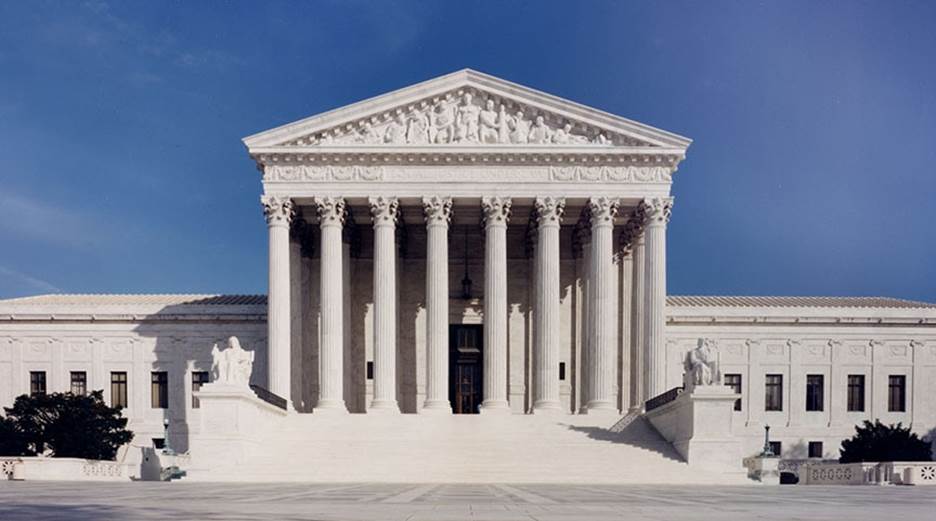
A student that has the drive and ability to get a spot in Harvard is going to do just fine in life if he attends University of Massachusetts instead – Photo Supreme Court
College Education and the Supreme Court
By Nayyer Ali MD

In two major decisions in June, the Supreme Court put its stamp on college education in the United States. In the first case, it ruled that race-conscious admissions program (known as Affirmative Action) was henceforth illegal in the United States, after being used for over fifty years. In the second case, it declared that President Biden’s plan to unilaterally forgive up to 20,000 dollars in student loans was also illegal and struck it down.
Liberals were distressed by both these rulings that were handed down by the six conservative judges placed on the court by Republican Presidents. While these decisions will affect a few students on the margin, neither of them really limits access to higher education for the vast majority of students.
Affirmative Action was conceived in the late 1960’s as a remedy for the effects of generations of slavery and then discrimination against African-Americans. The sense was that it would be unfair to force African-American students to adhere to the standards of White students due to legacy of systemic racism. The answer was to admit students by lowering the standards for African-Americans. This was then later expanded to Latino students. The Supreme Court twice was asked to strike this down on the grounds that it constituted a form of “reverse racism” against Whites, but in the 1970’s and again in the early 2000’s the Supreme Court allowed colleges to consider race and creating a diverse student body to be a legitimate academic goal, and allowed Affirmative Action to remain in place.
This led to the current challenge, where the plaintiffs were Asian-Americans asking the court to void Harvard’s Affirmative Action program as it was resulting in discrimination against Asian-Americans with much higher test scores and academic achievements who were being denied admission. Complicating this is that at many elite private universities, there is a practice of giving additional consideration to children of former students (called “legacy” admits), and to children of the professors who work at the university. It is also well-known that a large enough financial donation can often get a child admitted. This was the case with Donald Trump getting into Wharton and Jared Kushner getting into Harvard.
The court agreed with the plaintiffs that Harvard could no longer use a different standard for admission based on race. But it did not address the fairness of the legacy or donor system. There are certainly strong arguments that private schools should not use such practices, but as private institutions they are legally allowed to do so. Major public universities do not give special weight to legacy admissions, nor do they solicit funds for their endowments as they are funded by taxpayers.
What does the end of Affirmative Action mean in practice? The reality is that it only applied to a tiny slice of students. It was a program used only by the most selective schools in the entire country. Places like Harvard, Stanford, MIT, Caltech, Princeton, and Columbia admit less than 5% of the students who apply, though probably 20% of their applicants would perform just fine at these institutions and are academically well-prepared for these elite schools. Even schools like USC, UCLA, UC Berkeley, and NYU admit less than 15% of their applicants. But out of 15 million college students, only 5% attend a school that admits less than 25% of its applicants. The vast majority of American college students go to schools that admit just about everyone who has finished high school and wants to go to college. Major public universities with 20-40 thousand students each such as Cal State Los Angeles, Cal State Northridge, University of Texas Arlington, University of Arizona, Illinois State, and a host of others admit 90% of the students that apply. Affirmative Action does not even apply at the vast majority of colleges and universities because there is plenty of space for everyone. It is only an issue at perhaps the top 20 or so universities where space is limited and demand is massive. The number of African-American and Latino students benefiting from Affirmative Action is no more than a few thousand.
This is the deep fallacy of higher education. The belief that these top selective schools provide a secret knowledge that one cannot obtain by going to any of the other 1,200 accredited universities in the US. A student studying physics, or history, or computer science, or biology is not exposed to some secret truths if she attends UCLA rather than UC Davis. Going to one of these elite universities is a highly desired badge of honor among the elite and their children, but it is actually a rather meaningless prize.
Twenty years ago, a study came out that showed this to be true. It looked at a sample of students that got admitted to elite schools but chose not to attend them, for financial reasons or something else, and then followed their life course in comparison with a matched sample of students that did go to an elite school. It turned out that it made no difference. The two groups did equally well after graduation. A student that has the drive and ability to get a spot in Harvard is going to do just fine in life if he attends University of Massachusetts instead.
While the abolition of Affirmative Action will likely mean that enrollment of Black and Latino students at the most selective private and public universities will decline somewhat, those students will still end up doing fine by going to very good schools that are not quite so limited in the number of spots available. Elite schools can still give consideration to students based on life circumstances such as poverty that they may have overcome, but they cannot simply advantage a student based on race.
The student loan decision was also upsetting to many liberals, who believe that college simply costs too much. The Court however was correct that if the government wants to forgive 400 billion dollars worth of loans, that would require Congress to pass a law signed by the President, and cannot be done simply through unilateral Executive Action by the President. That would give the President too much power.
While there are some students who have large loan burdens and would benefit from loan forgiveness, college is still very affordable for the vast majority of students. The key is that students choose wisely where they go to college and what they study. For the vast majority of students there is no good reason to attend a private university if you have to borrow the tuition cost. Tuition at private schools can run from 35 to 55 thousand dollars per year. Add in another 15 thousand for living expenses, and the cost is very high. You can leave school 200,000 dollars in debt. The better option is going to public universities. In California, for example, the Cal State Universities offer excellent education for only six thousand dollars per year in tuition. With campuses throughout the state it is possible for many students to live at home while going to school, thereby saving on living costs. Summer jobs and part time work during the school year can earn students 10 thousand dollars or more towards the cost of their education. It is very possible to earn a four-year degree and leave with less than 30,000 dollars debt, less than the cost of a new car. The earnings boost from a college degree more than makes up for the cost of paying back the student loan.
However, if a student studies a subject that offers little in the way of job prospects, or if a student fails to get a degree but takes on significant debt, that can be a real problem. Making wise choices is clearly important. Another path to getting a college education at minimal cost is the community college system. These colleges offer coursework that cover the first two years of traditional college at almost no cost. Students can then transfer to a four-year school to complete the last two years of education and get their degrees.
The other problem with the Biden plan to forgive student loans is that it was very poorly targeted. Many students with good jobs that can easily afford to pay back their loans would get a huge benefit, while millions of kids who never went to college get nothing. Instead of forgiving loans in this blanket fashion, money should be made available for young people who are not going to college to learn useful blue-collar trades such as plumbing or electrician so they can be a skilled worker even though they never go to higher education.

